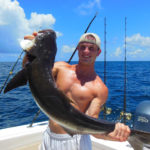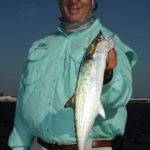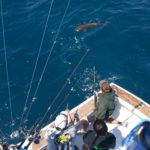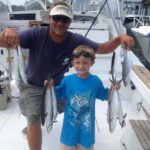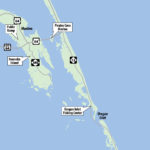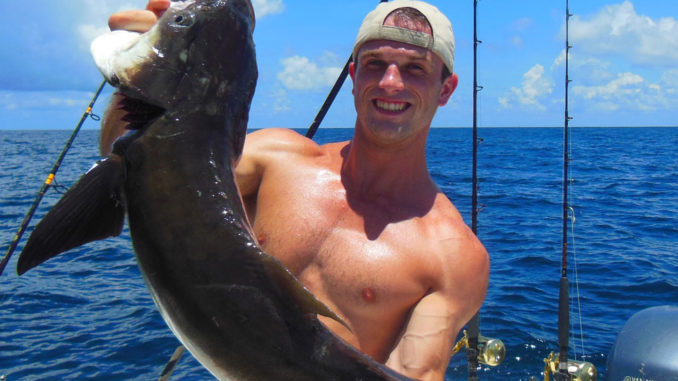
Spanish mackerel, cobia are often found in the same waters as June arrives along the northern end of the Outer Banks.
Most fishermen along the North Carolina coast are familiar with cobia and Spanish mackerel, but few think of them as a combined fishery.
Capt. Karl Helmkamp of Fistful Sportfishing in Manteo sees them that way, but not quite in the manner one might expect. He sees cobia as the primary target and Spanish mackerel as the secondary catch, rather than the other way around.
Helmkamp fishes for the little mackerel to help pass the time while searching for cobia and admits that Spanish add variety to the trip and help fill the cooler. But, he said, once a fisherman goes toe to fin with a big, bad cobia, he’s hooked and has to do it again.
“We’re fortunate to have good Spanish and cobia fisheries right outside Oregon Inlet and along the beaches,” Helmkamp said. “Our fishing begins when they make the turn at Cape Hatteras in the late spring and lasts until they leave in the late fall. Spanish fishing is pretty good summer and fall in many places, but nowhere else has spring, summer and fall cobia fishing like we do.”
Years ago, Helmkamp said, when he was running half-day trips for dolphin, Spanish and king mackerel, he saw a lot of cobia. He would sometimes slow down and cast to them, but it always created a lot of confusion when a cobia ran through a spread of baits intended for mackerel. Still, his clients seemed to like the action. At some point, Helmkamp realized that having a helm station on the fly bride of his boat allowed him to more easily spot cobia swimming just under the surface around rips, grass lines, tide lines and waves. With that kind of advantage, he decided to offer more opportunities to cast to cobia, and he’s never looked back.
“While we are looking for cobia, we troll two Spanish lines,” Helmkamp said. “One has a No. 1 planer and the other a No. 2 planer, with Clark Spoons behind both. With the different depths, we can see where Spanish are on that day. The range from 18 to 34 feet is usually the hot depth, but they can be anywhere from just below the surface to pretty deep.
“Spanish can be pretty spooky, too, so we run the lines long and put the lures well behind the planers on a combined leader using 60 feet of 40-pound monofilament to a 12-foot section of 25-pound fluorocarbon, then the lure.”
Helmkamp trolls spoons in silvers and golds and said that green or pink flash strips can be really hot at times. Once in a while, he’ll add small green and pink dusters or squids over the spoons to give them a flash of color, and he said nylons and smaller jigs with mylar strips often catch well, too. He likes to keep the Spanish biting and the fishermen in the cockpit busy while he searches for cobia.
When he finds a good school of Spanish, Helmkamp circles them a couple of times, staying just far enough off that he doesn’t spook them but close enough that the lures pull through the edge of the school. He said casting small jigs and lures on light spinning tackle makes catching Spanish more fun, and when they are thick, he’ll stop and let his clients catch them in that manner.
“You may have heard this before and wondered, but I can tell you it’s true,” Helmkamp said. “Three-inch sections of straws from convenience stores and fast-food restaurants, with a hook sticking out the back, will catch a lot of Spanish. I don’t know what it looks like to them, but the way they hit them, it must be something they like.
“The other thing to remember when trolling for Spanish is that they like fast food,” Helmkamp said. “Maybe that’s the connection with the straws? We troll pretty quickly, usually somewhere between 5 and 6.5 knots. This speed is a little quick for bluefish, so we don’t catch many. However, if you want a mess of blues, all you have to do is slow down.”
Helmkamp said that if the Spanish are thick, cobia may be nearby. He said they like a lot of the same water, with cobia sometimes also being in deeper water. Other fish like these same areas, and Helmkamp said he often finds acre-sized schools of big red drum and huge schools of chopper blues in addition to the Spanish and cobia.
When a cobia is spotted, Helmkamp said things get serious quickly. It may be a single fish or a pair, but often it is a small pack trailing along with a ray or a turtle. The rods rigged to troll for mackerel might be in the way of a cast, but their lines will almost always be in the way if a cobia bites before they are cleared. This adds hustle and excitement to get them cleared as soon as a cobia is spotted.
“Our cobia fishing is the real deal,” Helmkamp said. “You see the fish and then move to get in casting range without spooking it. It’s a combination of patience, being ready, strength and skill. When the time comes, the cast has to be right. It’s up close and personal, and you’ll see the fish react to the bait. You have to jig or pause to entice it to bite and be ready, but not overanxious, to set the hook.
“Once the fish hits, the deal is on until something gives, and hopefully it’s the fish,” Helmkamp said. “Your adrenaline is wide open at first, but it can be a long fight, and you get tired. These are big fish and they don’t give up easy. We caught five heavier than 80 pounds last year and a bunch a little smaller. You better be ready when the opportunity comes.”
When he casts to cobia, Helmkamp uses stout spinning outfits: a 7-foot Nathan Pruitt custom rod rated 30 to 60 pounds, paired with a Penn Battle 6000 reel filled with 80-pound braid with a 4-foot leader of 60- to 80-pound fluorocarbon. Some rods are rigged with 2- or 3-ounce orange, white, pink or brown Bomber Cobia Jigs tipped with squid, squid strips or large grubs that have been liberally sprayed with scent, while some have an 8/0 circle hook baited with a live eel.
Cobia possess a unique combination of speed, brute strength and dogged determination, and they don’t allow themselves to be led to the boat easily. They typically travel in pairs or small packs, so there is also a definite possibility to hook doubles, triples and more, which adds the extra challenge of keeping the lines from tangling.
Once at the boat, legal-size cobia (33 inches fork length or greater) are gaffed and hoisted into the fish box. They usually save one last burst of energy for when they are on the boat, and the best way to deal with that is to get them immediately in the fish box and have someone sit or stand on it until the cobia calms down.
DESTINATION INFORMATION
HOW TO GET THERE — Oregon Inlet separates Bodie Island from Hatteras Island, about 8 miles from Nags Head, which is the eastern terminus of US 64. It is best accessed from two marinas — Pirates Cove in Manteo on Roanoke Island, Oregon Inlet Fishing Center just north of Oregon Inlet. Two public boat ramps are on Roanoke Island, one next to the US 64 bridge to Nags Head and one on Bowsertown Road on the western side of the island. A public ramp is at the former location of Manns Harbor Marina on the mainland side of the US 64 bridge across Croatan Sound. The closest ramp to the inlet, however is a public ramp at Oregon Inlet Fishing Center off NC 12 on the north side of the Herbert C. Bonner Bridge.
WHEN TO GO — Spanish mackerel and cobia typically arrive off the Outer Banks during May and are around until the water cools in the fall. The numbers are best in the spring, with the largest cobia in the spring and the largest Spanish mackerel in the fall.
BEST TECHNIQUES — Most Spanish mackerel are caught trolling size 00 to 1 Clark Spoons in gold, silver or with green and/or pink flash strips. Fast-action boat roads are the preferred equipment, with reels spooled with 60-pound braid and a long leader of 40-pound mono with a 12-foot section of 25-pound fluorocarbon on the business end. Planers are often used to get spoons down in the water column. For cobia, use 7-foot spinning rods rated for 30 to 60 pounds, with 6000 class reels spooled with 80-pound braid and a 4-foot leader of 60- to 80-pound fluorocarbon. Casting to cobia is done with 2- to 3-ounce Bomber cobia jigs in orange, white, pink or brown tipped with whole squid, squid strips or large, soft-plastic curlytails. Live eels rigged on 8/0 circle hooks are another option.
FISHING INFO/GUIDES — Capt. Karl Helmkamp, Fistful Sportfishing, 252-395-1907, www.fistfulsportfishing.com; Pirate’s Cove Marina, 800-367-4728, www.fishpiratescove.com; Oregon Inlet Fishing Center, 252-441-6301, www.oregon-inlet.com. See also Guides and Charters in Classifieds.
ACCOMMODATIONS — Dare Haven Motel, Manteo, 252-473-2322, www.darehaven.com, is locally owned and set up to serve fishermen’s needs; Outer Banks Chamber of Commerce, 800-627-3150, www.outerbankschamber.com.
MAPS — Capt. Segull’s Nautical Charts, 888-473-4855, www.captainsegullcharts.com; Sealake Fishing Guides, 800-411-0185, www.thegoodspots.com; Maps Unique, 910-458-9923, www.offshore-fishing-map.com; Grease Charts, 252-560-6527, www.greasechart.com, GMCO’s Chartbook of North Carolina, 888-420-6277, www.gmcomaps.com.

